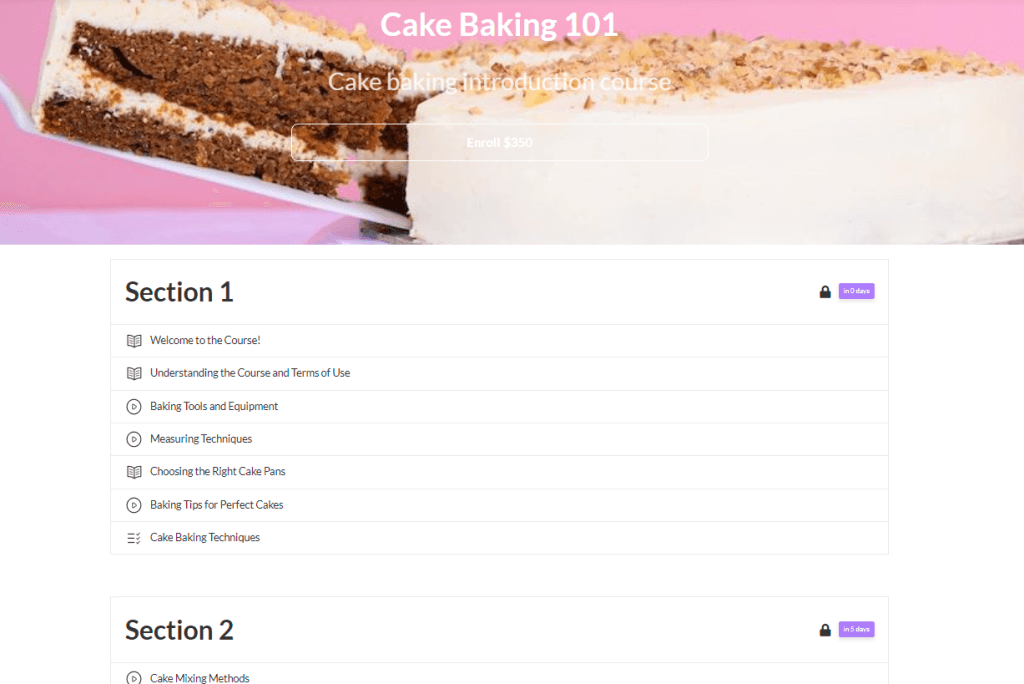Table of Contents
Delivering an online course is like telling a story. As every good storyteller knows, a masterful narration cultivates anticipation and ignites readers’ curiosity.
Your prowess as a storyteller directly translates to your ability to skillfully guide and inspire individuals, compelling them to embark on a journey of learning, under your guidance.
As a teacher and instructor, there are times when you might need to adjust the pace of your storytelling. This can be useful for managing the timing, keeping the reader engaged, and maintaining a smooth flow of content.
In the same way, every instructor needs to be in control of how their course is being delivered. This implies the need to regulate the pace, the quality – but also the quantity, of the learning content you provide to your learners. A highly effective approach or achieving this is through the use of drip-feeding.
Drip-feeding is a technique that allows you to gain better control of the e-learning materials you distribute to your online students.

But, what exactly is drip-feeding and how can it help you? This article goes into much detail explaining what this revolutionary content strategy has to offer…
So, let’s find out!
What is Drip-Feeding?
As the term suggests, drip-feeding refers to ‘introducing (fluid) drop-by-drop’ or providing something gradually and in small amounts.
In eLearning this describes the constant supply of course content delivered in small quantities or smaller chunks over time, rather than delivering large amounts of information all at once.
So, drip-feeding is all about scheduling the delivery of your online courses and deciding which parts of your course will become available and when.
With it, your learners get the course material in stages. This means that they don’t get the content all in one go, but gradually gain access to it at a set-specific time or intervals.
This is a set amount of time that you can choose – usually a number of days, or a week after, starting from the date they enrolled in your course, or a specific date for cohort learning.
What is not Drip-Feeding?
Drip feeding is very different from self-paced learning. In fact, it’s the exact opposite. With a self-paced online course, students get access to all of the content of your course, immediately after purchasing it. This means that they get all the available information at once without having to wait.
If you are in doubt about what you use as both have their advantages and disadvantages, think of the complexity or the level of difficulty of your course material.
Ask yourself whether it is complex or difficult-to-comprehend material that your student will need more time to digest. If that’s the case, drip-feeding is your best option.
The Benefits of Drip-Feeding
There are many benefits to drip-feeding that are worth mentioning.
Drip-feeding can boost the value of your online course, and help increase your course sales revenue, acting as a powerful content delivery method.
As Spaced Learning Theory suggests, learning is more effective when information is presented with intervals in between, and drip feeding is a strategy that operationalizes this theory by gradually delivering content over time to enhance retention and understanding.
The theory’s basic idea is that by exposing learners to the same information multiple times, but with gaps in between, the brain has more opportunities to process and encode the information into long-term memory.
This repeated exposure to the material strengthens memory traces, making the information more likely to be retained, combating the “forgetting curve” – a phenomenon that suggests learners forget a significant portion of newly learned information shortly after the initial exposure.
But there is more to it:

1It is time-saving
Drip-feeding automates the process of lesson/course scheduling providing a quick and easy way to deliver your content. This way your students receive the learning material as they complete each stage of the lesson delivery and it goes on without the need for re-rescheduling.
2It provides alternative purchase options
You can offer your course as a subscription where the student stays to unlock higher levels of knowledge e.g. beginner’s level, intermediate level, expert level.
This can be more profitable, as students pay for longer, and you can continue adding content and keeping them engaged for more.
3It builds student/customer engagement
The gradual delivery of lessons allows students to follow their own pace of learning instead of overwhelming them with course materials all at once. This way you help to maintain your customer lead as it gives students another reason to keep coming back – or better yet, something to look forward to.
4It creates more trust
A school that offers learning materials offered in stages may be considered more valuable as opposed to one that offers all the course materials from the start.
This provides proof that your online school is well-thought-out and provides a professional service with a plan-out schedule for lesson delivery.
5It protects you from money-back guarantees
With drip feeding, you protect yourself and your content from money-back guarantees because it delivers enough information for students to see and try the product, but you don’t give them everything right away.
They pay less in the beginning and can “try” the course before moving forward. Compared to higher costs upfront, drip course content at a lower-cost subscription might make more sense and avoid some refund requests.
How does drip-feeding work?
Using drip-feeding as part of your content delivery strategy is really easy and can improve the learning experience.
An online learning strategy when using drip-feeding more or less could look like this:
Example 1: Cake Baking Course
Day 1 – Unlocks upon registration and sign-up
Day 5 – Unlocks 5 days after purchase
Day 10 – Unlocks 10 days after purchase
Example 2: Online Photography Course
Another example would be to schedule your drip learning in the duration of let’s say up to 10 weeks and have one section unlocked every week.
First day:
On the first day of the course, participants are granted access to the introductory module. This module covers the basics of photography, camera settings, and composition.
1 week later:
After a week, participants unlock Module 2, which dives deeper into different types of photography, such as landscape, portrait, and macro photography. This module also introduces concepts like lighting and framing in an interactive way.
2 weeks later:
In the third week, participants gain access to Module 3. This module focuses on post-processing techniques using photo editing software. Participants learn how to enhance their images through adjustments in contrast, color balance, and retouching.
3 weeks later:
Module 4 becomes available. This module delves into advanced training programs like photography gear, lens selection, and understanding exposure in more detail.
This gradual release of content allows learners to absorb and apply each module’s information before moving on to the next, fostering a steady learning curve.
You can even come up with an engaging call-to-action title for your course, to entice your learners e.g. “10 Weeks to Mastering Photography’. Every week students will get an email saying that another step (course section) has been unlocked, gradually nudging them to complete the training course.
Using Email Drip Campaigns to Promote Your Courses
An excellent way to plan out your drip-feed strategy is through drip campaigns.
Research finds that drip email campaigns can be a powerful marketing tool as they get a high click rate, even at a 119 percent increase.
You can use email marketing through drip campaigns to educate your users and provide relevant course information, reward them, or encourage them to check out your new products.
If you are new to this, there are many software that can help you manage your drip campaign effectively. This should depend on the learning management system (LMS) you are using and the capabilities it comes with since not every LMS offers drip-feeding.
LearnWorlds comes with the email marketing & automation tools you need to set up the process without additional integrations needed!
How to Setup Your LearnWorlds School for Drip Feeding Courses
There is no doubt that drip-feeding offers immense potential in terms of what you can do with your LMS to market your courses and engage your students.
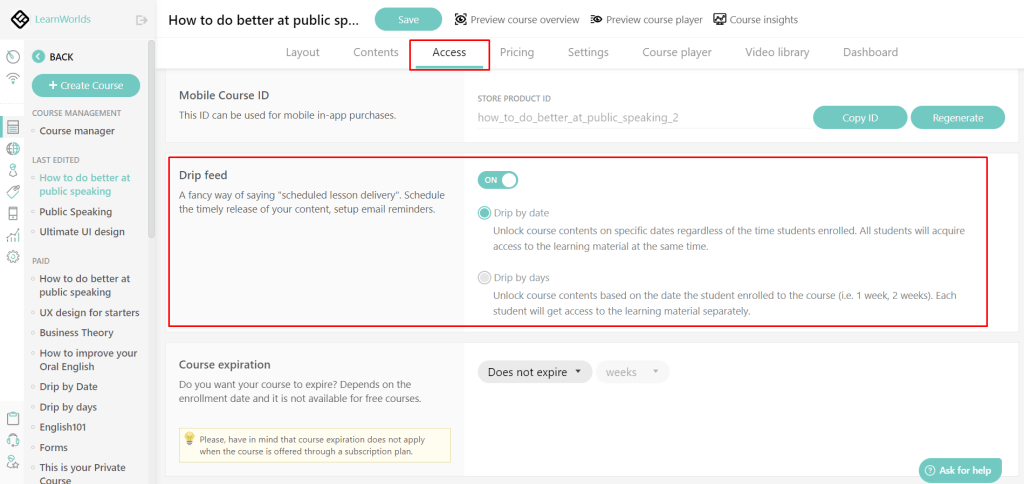
Enabling the Drip-feed option inside LearnWorlds
If you are using LearnWorlds, you can set it up for specific days or dates just as quickly as lightning! The only thing you need to do is enable the feature from inside the platform and choose the course (once it is created). If you haven’t created a course yet, follow these three simple steps:
1Create an online course
Start by creating your course materials and have them ready for students to use and access.

From the Course Wizard, choose your course title, course URL, type of course, and price and customize it further to make it work best for you.
2Add your sections and course content
There is a range of learning tools you can use to engage and educate your students. Useful learning material includes videos presentation, webinars, workbooks, learner assessments, puzzles, quizzes, feedback surveys, etc.
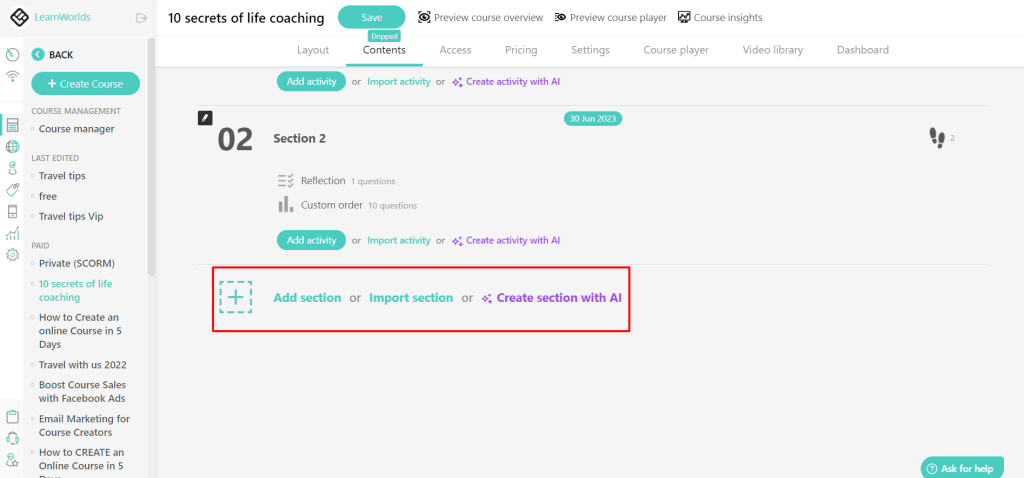
Learn how to use sections to organize your content here.
At this point, you can also decide how you will divide your course content and how many sections or lessons you want to include in it.
3Decide when you want to deliver your course
You can set up the course delivery date once, and then ‘the clock starts’ and the lesson is scheduled to be delivered on the same day to every student, no matter when they first signed up for the course.
So if you scheduled for it to be delivered after 3 days or a week after the sign-up, then it will be delivered to each student with the appropriate timely delay.
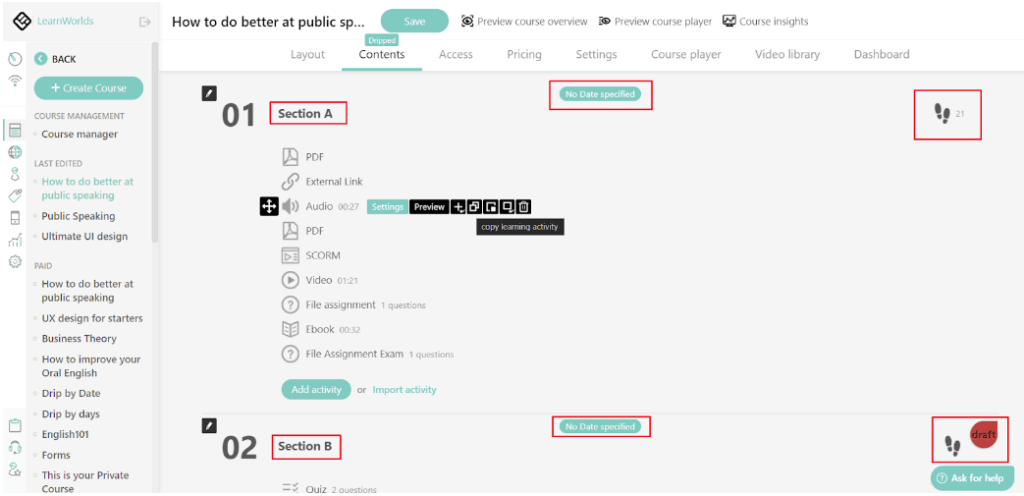
Drip-feeding content by date.
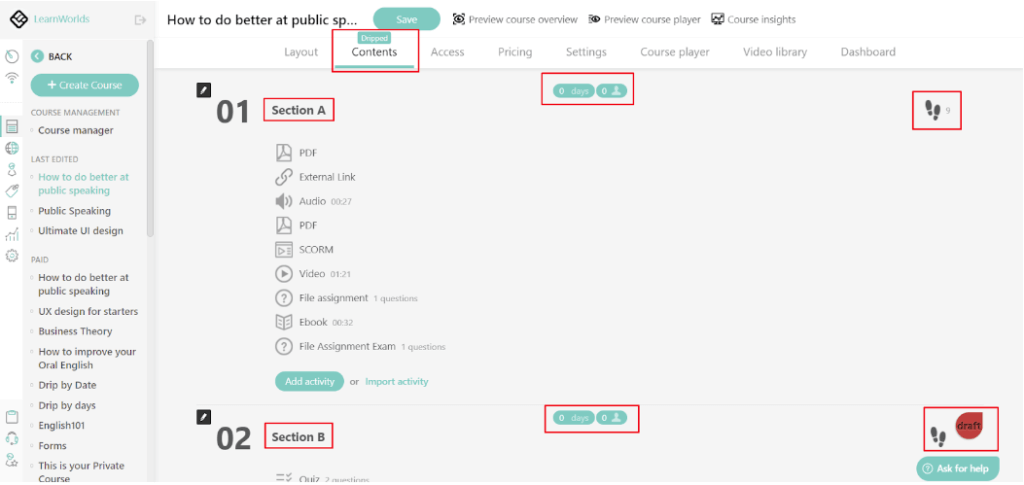
Drip-feeding content by days.
From there on, you decide how you want your lesson to be delivered. Until today, the most frequent way to drip-feed was through auto-responders which sent informative emails about a new lesson – or a course that became available. However, more increasingly recently, people are turning to full-course platforms that allow you to both build your online course and schedule your course delivery.
💡 Read our full support article on how to drip-feed your courses with LearnWorlds.
Utilizing Drip-Feeding to Boost Your Course Sales
Drip-feed courses are increasingly popular with course creators and learners alike, as they provide a more engaging learning journey through microlearning.
Drip-feeding today is not just a nice-to-have feature of an online academy, it’s an expected feature of any e-learning or training provider.
And, you probably need a great LMS to host your drip-feed courses!
LearnWorlds LMS is the best solution you can use to set up your drip training, as it comes with all the built-in features you need. From course creation, marketing, to reporting metrics & analytics for elearning!
Kyriaki is a Content Creator for the LearnWorlds team writing about marketing and e-learning, helping course creators on their journey to create, market, and sell their online courses. Equipped with a degree in Career Guidance, she has a strong background in education management and career success. In her free time, she gets crafty and musical.


